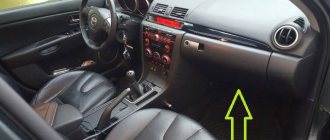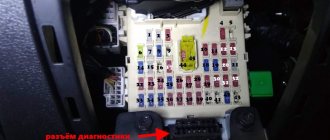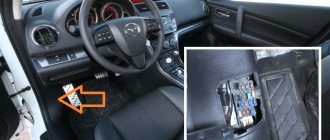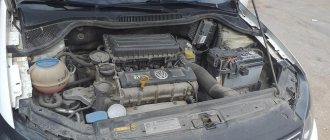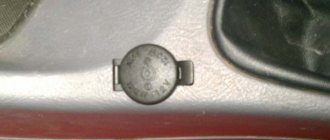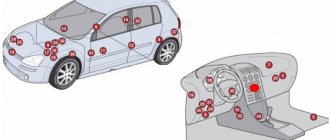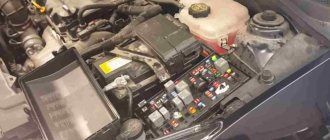The Opel Astra J first debuted at the motor show in Frankfurt am Main (Germany) in 2009. The production of the Opel Astra J in Russia began in 2010, respectively, it was produced here in 2010, 2011, 2012, 2013, 2014 and 2015- s years.
The Opel Astra J was presented in three body variations: hatchback (GTC, OPC), station wagon and sedan. This model could have a gasoline or diesel engine with a volume of 1.3 l CDTI, 1.4 l (A 14 XER), 1.4 l (A 14 NET, turbo), 1.6 l (A 16 XER), 1.6 l (A 16 LET, turbo) , 1.7 CDTI, 1.8 l, 2.0 l.
From our article you will learn where the fuse and relay blocks are located with their diagrams, descriptions and purposes. We especially note the washer and cigarette lighter fuses.
Interior fuse and relay box
The pre-storage unit in the Opel Astra J interior is located on the driver’s side (left) behind the glove compartment (glove compartment).
To access the fuse and relay box you must:
- Open the box and push its right wall to the left;
- Then remove the limiter on this wall from the hook with the edge of the socket in the instrument panel;
- All that remains is to fold the storage compartment down and remove its hinges from the grooves in the instrument panel.
Fuse diagram in the interior of the Opel Astra j
| No. on the diagram | Denomination pre-la | Protected circuit |
| 1 | 10 A | Display/Driver Information Screen (DIC), Radio Control |
| 2 | 20 A | Exterior lighting, body electronics control unit |
| 3 | 25 A | Body electronics control unit |
| 4 | 20 A | Radio (audio system, radio), |
| 5 | 7.5 A | Infotainment system, multimedia player, cell phone |
| 6 | 20 A | Cigarette lighter (front power outlet) |
| 7 | 20 A | Rear power socket for accessories |
| 8 | 30 A | Low beam (halogen) - Left headlight |
| 9 | 30 A | Low beam (halogen) - Right headlight |
| 10 | 30 A | Door locks (Central locking) |
| 11 | 40 A | Heating/heating (ventilation) and interior air conditioning systems (stove and air conditioner fan) |
| 12 | 25 A | Electric motor/driver's seat (adjustable position and lumbar support) |
| 13 | — | Empty (Reserved) |
| 14 | 7.5 A | Connector for Diagnostics (diagnostic plug) |
| 15 | 7.5 A | Airbags (SRS Airbag) |
| 16 | — | Empty (Reserved) |
| 17 | 10 A | Air conditioning (A/C); control panel for the ventilation, heating and air conditioning system |
| 18 | 30 A | Logistics mode No. 1 |
| 19 | 20 A | Stop lights, reversing lights, courtesy lights/lamp |
| 20 | 5 A | System for detecting the presence of passengers inside the cabin |
| 21 | 10 A | Dashboard |
| 22 | 5 A | Ignition; egnition lock |
| 23 | 20 A | Body electronics control unit |
| 24 | 20 A | Body electronics control unit |
| 25 | — | Empty (Reserved) |
| 26 | — | Empty (Reserved) |
The cigarette lighter fuse is number 6 (front) and 7 (rear) with a current rating of 20 amps.
Installation locations
When creating the car, the company's designers took into account errors in the location of the mounting blocks not only of previous cars, but also of other well-known car brands. Everything is done so that the vehicle owner can easily get to the faulty part and calmly replace it with a new one. The Opel Astra j has three such seats:
- car interior;
- under the hood in the engine compartment;
- in the luggage compartment.
Block under the hood
In the engine compartment, the fuse box is located next to the battery.
To access you need:
Use a screwdriver (or your fingers) to press out the two latches and remove the protective cover.
Fuse and relay diagram under the hood of the Opel Astra j
| No. on the diagram | Denomination pre-la | Protected circuit |
| 1 | 10 A (gasoline) and 20 A (diesel) | (ECU) engine control module (ECM) |
| 2 | 10 A | Oxygen concentration sensor |
| 3 | 15 A | Fuel injection, ignition system (4 fuel injectors, ignition coil) |
| 4 | — | Empty (Reserved) |
| 5 | — | Empty (Reserved) |
| 6 | 7.5 A | Heated/heated mirrors (side mirrors left and right) |
| 7 | 5 A | Radiator Fan Control (Medium Speed Relay), Electric Fan Motor |
| 8 | 7.5 A | Oxygen concentration sensor |
| 9 | 7.5 A | Sensor / Rear Window Sensor, Body Control Module |
| 10 | 5 A | Battery sensor |
| 11 | 7.5 A | Trunk/tailgate release button |
| 12 | 5 A | Front adaptive lighting control module (interior lamps) |
| 13 | — | Empty (Reserved) |
| 14 | 20 A | Rear windshield wiper (rear wiper motor) |
| 15 | 10 A | (ECU) engine control module (ECM) |
| 16 | 30 A | Starter |
| 17 | 10 A | Transmission control system (TCM) |
| 18 | 40 A | Heated / heated rear window (heating filaments) |
| 19 | 30 A | Driver and passenger front power windows |
| 20 | 30 A | Rear passenger power windows (right and left) |
| 21 | 30 A | ABS brake system |
| 22 | 10 A | High beam - Left headlight |
| 23 | 25 A | Headlight washers (pump) |
| 24 | 15 A | Low beam (xenon) - Right headlight |
| 25 | 15 A | Low beam (xenon) - Left headlight |
| 26 | 15 A | Front left and right fog lights (fog lights) |
| 27 | 30 A | Electric diesel fuel heater |
| 28 | — | Empty (Reserved) |
| 29 | 30 A | Electric parking brake (Handbrake) |
| 30 | 60 A | ABS brake system |
| 31 | — | Empty (Reserved) |
| 32 | 5 A | Airbags (SRS Airbag) |
| 33 | 15 A | Headlight leveling control system (AFL) see also No. 50 |
| 34 | — | Empty (Reserved) |
| 35 | 5 A | Driver's side power window switch, side mirror control switch |
| 36 | — | Empty (Reserved) |
| 37 | Canister purge solenoid valve | |
| 38 | 20 A | Vacuum pump (gasoline) |
| 39 | 20 A | Fuel pump flow regulator module (fuel pressure regulator) (gasoline) |
| 40 | 10 A | Windshield (front) glass washers, rear window washer; washer motor |
| 41 | 10 A | High beam - Right headlight |
| 42 | 40 A | Engine cooling radiator fan |
| 43 | 30 A | Front windshield wiper (front wiper motor) |
| 44 | — | Empty (Reserved) |
| 45 | 30 A | Engine cooling radiator fan (petrol engine) |
| 46 | — | Empty (Reserved) |
| 47 | 15 A | Signal (horn, horn) |
| 48 | 60 A | Cooling fan 1 medium speed, cooling fan low (small) speed, cooling fan high (increased) speed |
| 49 | 20 A | Gasoline pump (fuel pump) |
| 50 | 10 A | Headlight adjustment system (headlight corrector); adjusting the angle of the right and left headlights |
| 51 | Throttle module | |
| 52 | 7.5 A | Heating of crankcase gases |
| 53 | 7.5 A | Transmission control system (automatic transmission), (ECU), engine control unit (ECM), glow plug control unit (GPCM) (for diesel cars) |
| 54 | 7.5 A | Electrical wiring control; Brake Power Vacuum Switch, Fuel Pump Control System, Water in Fuel Sensor, Auxiliary Electric Heater, K33 HVAC Control Module, P16 Instrument Cluster, B108 Air Quality Sensor, B19C Brake Power Vacuum Switch, B75B Mass Flow Sensor air/intake air temperature |
| Z1 | 80 A | Diesel models: glow plug control unit |
| Z2 | 80 A | Steering system control unit with servo amplifier |
| Z3 | 100 A | Additional (auxiliary) electric heater |
| Z4 | 80 A | Electric cooling fan motor |
The washer fuse is number 40 with a current of 10 Amps.
Relay in the block under the hood
| No. on the diagram | Protected circuit |
| R1 | Empty (Reserved) |
| R2 | Starter relay |
| R3 | Engine Control (EC) Relay, Transmission |
| R4 | Rear window heating/defogger relay |
| R5 | Headlight washer pump relay |
| R6 | Low Beam Headlight Relay - Left Headlight, Daytime Running Light (Dimensions) |
| R7 | Fuel pump relay |
| R8 | Low Beam Headlight Relay - Right Headlight, Daytime Running Light (Dimensions) |
| R9 | Fuel heater relay (diesel) |
| R10 | Empty (Reserved) |
| R11 | Cooling fan 1st (low, low) speed relay |
| R12 | Cooling Fan Overspeed Relay |
| R13 | Cooling Fan Medium Speed Relay 1 |
| R14 | Main ignition relay |
There are also maintenance-free relays inside the mounting block. To get to them, you need to remove the fuse mounting block and disassemble its plastic protective casing to remove the main board with relays and fuses.
Maintenance-free relays on the back of the board with fuses and relays under the hood
| No. on the diagram | Protected circuit |
| Maintenance-free relays located inside the unit | |
| R1 | Signal Relay (horn, horn) |
| R2 | Rear window washer pump relay |
| R3 | Rear window wiper relay |
| R4 | Front windshield washer pump relay |
| R5 | Air Conditioning Relay (A/C), A/C Compressor Clutch |
| R6 | Fog lamp relay (front fog lights) |
| R7 | High beam relay |
| R8 | Fuel filler door opening motor relay |
| R9 | Rear tailgate lock opening relay (including trunk lid) |
For information: The generator voltage regulator relay is installed in the engine compartment next to the generator itself; it is not in the main fuse and relay box.
How to replace it yourself?
To replace elements in the interior mounting block, no special tools are required. All you need is a slotted screwdriver and a set of new fuses.
Replacing fuses
Guidelines for replacing failed fuses, for example those responsible for the operation of a stove or cigarette lighter, are as follows:
- Turn off the vehicle's ignition system.
- Open the small folding box on the instrument panel, located near the knee of the driver's left leg.
- Press the plastic clips located on the sides and remove the drawer body from the frame.
- Unscrew the four slotted screws securing the frame.
- Remove the mounting block from its place by pulling the bottom part.
- Replace the faulty fuse. To do this, the damaged fuse element must be removed from the socket. The mounting block comes with small plastic pliers. They need to clamp the fuse body, pull it out of its seat and insert a new part.
- Visually check the condition of the remaining fusible links.
- Reassemble.
It is important to note that the new fuse must have the same rating as the failed one. If such a detail is missing, an element of slightly larger value can be used. Just first you need to check the working condition of the circuit; for this you should install a fuse from any other socket with the required rating. If the fuse remains intact, then a part with a higher rating should be installed instead. But at the first opportunity it should be replaced with a part with a standard rating. Since long-term use of an inappropriate fuse can lead to damage to the vehicle's electrical systems and fire. If after replacing the fuse it immediately fails, then it is necessary to find out the cause of the overload in the electrical circuit.
The process of changing fuses on more modern Opel Astra H 2008 or Opel GTC 2012 is identical to the above.
Replacing parts in the engine compartment is even simpler. To do this, you need to unfasten the plastic covers of the blocks and replace damaged fuses or relays.
Removing the relay box cover
Removing the fuse box cover
Block in the trunk
In the luggage compartment, the fuse and relay box is located on the left side under the side wall trim.
To access you need:
- Turn the lock of the trim cover 90 degrees and fold it down.
Fuse and relay diagram in the luggage compartment of the Opel Astra j
| No. on the diagram | Denomination pre-la | Protected circuit |
| 1 | 40 A | Trailer control unit |
| 2 | 30 A | Towbar, towing device (trailer plug connector, trailer socket) |
| 3 | 5 A | Parktronic; Parking assistance system |
| 4 | — | Empty (Reserved) |
| 5 | — | Empty (Reserved) |
| 6 | — | Empty (Reserved) |
| 7 | 10 A | Electric motor/passenger seat drive (position and lumbar support adjustment) |
| 8 | 5 A | Alarm (anti-theft) |
| 9 | — | Empty (Reserved) |
| 10 | 5 A | Body electronics control unit |
| 11 | 5 A | Tire pressure sensor, trailer alarm (light) |
| 12 | — | Empty (Reserved) |
| 13 | 20 A | Towbar, towing device (trailer plug connector, trailer socket) |
| 14 | — | Empty (Reserved) |
| 15 | 7.5 A | Side Rear View Mirror Switch, Driver Power Window Switch |
| 16 | 5 A | Dimmable interior rearview mirror |
| 17 | 20 A | 12 V socket in the trunk (station wagon) |
| 18 | — | Empty (Reserved) |
| 19 | 10 A | Heated steering wheel (heated steering wheel) |
| 20 | 20 A | Sunroof |
| 21 | 25 A | Heated/heated seats |
| 22 | — | Empty (Reserved) |
| 23 | — | Empty (Reserved) |
| 24 | — | Empty (Reserved) |
| 25 | — | Empty (Reserved) |
| 26 | — | Empty (Reserved) |
| 27 | — | Empty (Reserved) |
| 28 | — | Empty (Reserved) |
| 29 | — | Empty (Reserved) |
| 30 | — | Empty (Reserved) |
| 31 | 30 A | Audio system (radio) amplifier |
| 32 | 10 A | Active Suspension Damping System, Lane Departure Warning System |
Relay in trunk
| No. on the diagram | Protected circuit |
| R1 | Ignition relay 0 |
| R2 | Ignition relay 1 |
| R3 | Door lock relay |
| R4 | Empty (Reserved) |
Luggage compartment
There is a small hatch on the wall inside the trunk. If you turn its fastening, the hatch will open and the third safety block will be visible.
| Number | What is he responsible for? |
| 1, 2 | Trailer electrical connection / socket |
| 3 | Parking sensors |
| 8 | Sound and light alarm |
| 11 | Trailer connector |
| 19 | Steering wheel heater |
| 20 | Electric sunroof on the roof of a car |
| 21 | Heated front and rear seats |
| 31 | Sound notification in the cabin |
| 32 | Warning of crossing the road median |
Adjustment of maintenance period
How to reset the Opel Astra G (Opel Astra Classic II) service light. By year: 1998, 1999, 2000, 2001, 2002, 2003, 2004, 2005, 2006:
- The ignition is turned off.
- Press and hold the trip odometer reset button.
- Turn on the ignition one position before starting the engine.
- The INSP technical symbols will appear on the display for approximately 2 seconds.
- Hold down the trip odometer button until the display shows "- - -".
If the above procedure for resetting the Opel Astra G service indicator does not work, try this:
- Get into the car and close the door.
- Press and hold the brake pedal.
- Press and hold the trip reset button with the brake still applied.
- Turn on the ignition one position before starting the engine.
- The display will show "InSP" and under InSP it will be "- - - -".
- Continue holding the release button and the brake pedal for about 15 seconds.
At this point, InSP should flash, and then the computer will reset the mileage to 19,000 (in some cases, instead of 19,000, another number will appear, for example, 15,000 or 30,000). You can release the off button and brake pedal and the indicator will be reset.
Service interval reset button
How do you reset the Opel Astra H (Opel Astra Classic III) service indicator? By year: 2004, 2005, 2006, 2007, 2008, 2009, 2010, 2011, 2012:
- Get into the car and close the door.
- Press and hold the brake pedal.
- Press and hold the shutdown reset button with the brake still depressed.
- Turn on the ignition one position before starting the engine.
- The display will show "InSP" and under InSP it will be "- - - -".
- Continue holding the release button and the brake pedal for about 15 seconds.
At this point, InSP should flash and then reset the mileage to 19,000 (in some cases, instead of 19,000, another number will appear, for example, 15,000 or 30,000). You can release the off button and brake pedal and the indicator will be reset.
If the above procedure for resetting the Opel Astra H service indicator does not work, try this:
- The ignition is turned off.
- Press and hold the trip odometer reset button.
- Turn on the ignition one position before starting the engine.
- The INSP symbols will light up on the display for approximately 2 seconds.
- Hold down the trip odometer button until the display shows "- - -".
- You can release the power off button, the indicator is now reset.
How can you reset the service interval on Opel Astra J 2009, 2010, 2011, 2012:
- Turn on the ignition one position before starting the engine.
- Press the MENU button until the vehicle information and settings menu appears on the display.
- Rotate the two arrow button located next to the MENU button up and down until the message “Oil Life Remaining” appears.
- Press and hold the SET/CLR button and press the brake pedal.
- Release the SET/CLR button and brake pedal, turn off the ignition.
The choice of service is always yours, although many motorists seek a full MOT, knowing that checking all routine aspects beforehand can ultimately improve performance and extend the life of the car. A mechanical review of features including tires, brakes, filters, and fluids can also help prevent any long-term problems from occurring and avoid unpleasant costs!
Enabling/disabling the anti-theft alarm
Inclusion
Make sure the hood and trunk lid are also locked. When the alarm is triggered, an acoustic signal is activated (3 signals from the volume sensors, a maximum of 10 signals from other sensors) and the direction indicators begin to flash. The maximum duration of the siren operation is 30 seconds, the blinking of the direction indicators continues for up to 5 minutes. During the first 10 seconds after the alarm is activated:
- LED lights up continuously: Monitoring, switch-on delay
- LED flashes: Any of the controlled locks is not locked, or the system is faulty
10 seconds after the alarm is activated:
- LED flashes: Anti-theft alarm activated
- LED lights up continuously for 1 second: Function deactivated.
Unlocking and locking doors using a key from outside the vehicle
Common Opel Astra ECU malfunctions
Common Opel Astra ECU malfunctions occur for the following reasons:
- mechanical damage. The engine control unit is damaged by shocks and strong vibrations, which contribute to the appearance of microcracks in its circuits and housing;
- sudden temperature changes, as a result of which the engine control unit itself overheats;
- corrosion;
- depressurization and moisture ingress into the ECU housing;
- interference in the work of a block of people who do not have the necessary skills;
- the so-called “lighting up” from a car with the engine running;
- rearranging the terminals when connecting the battery;
- turning on the starter without a connected power bus.
All of the above factors have different effects on the performance of the engine control unit. Some of them cause minor damage to the “brains” of the car, while others can instantly break the unit. Fortunately, there is still a way to prevent the complete breakdown of the unit - ECU diagnostics, which should be performed at least once a year. This is the only way to save on expensive repairs of a part or its complete replacement.
Engine immobilization system
Damage to the microchip may result in loss of the ability to start the engine! Do not allow the keys to heat up excessively, do not leave them in direct sunlight for a long time; try not to drop the keys or place heavy objects on them; Avoid exposure to moisture; carefully wipe the wet set dry with a soft cloth. No replaceable batteries are provided for the microchip; under no circumstances should you attempt to disassemble the key head on your own! Instrument panel Engine preheater indicator lamp (diesel models)
There is a possibility that the system will not recognize the code of the key located in the ignition switch if there is any other key with a built-in microchip nearby. To reliably identify the code, we recommend keeping each key in a separate keychain.
